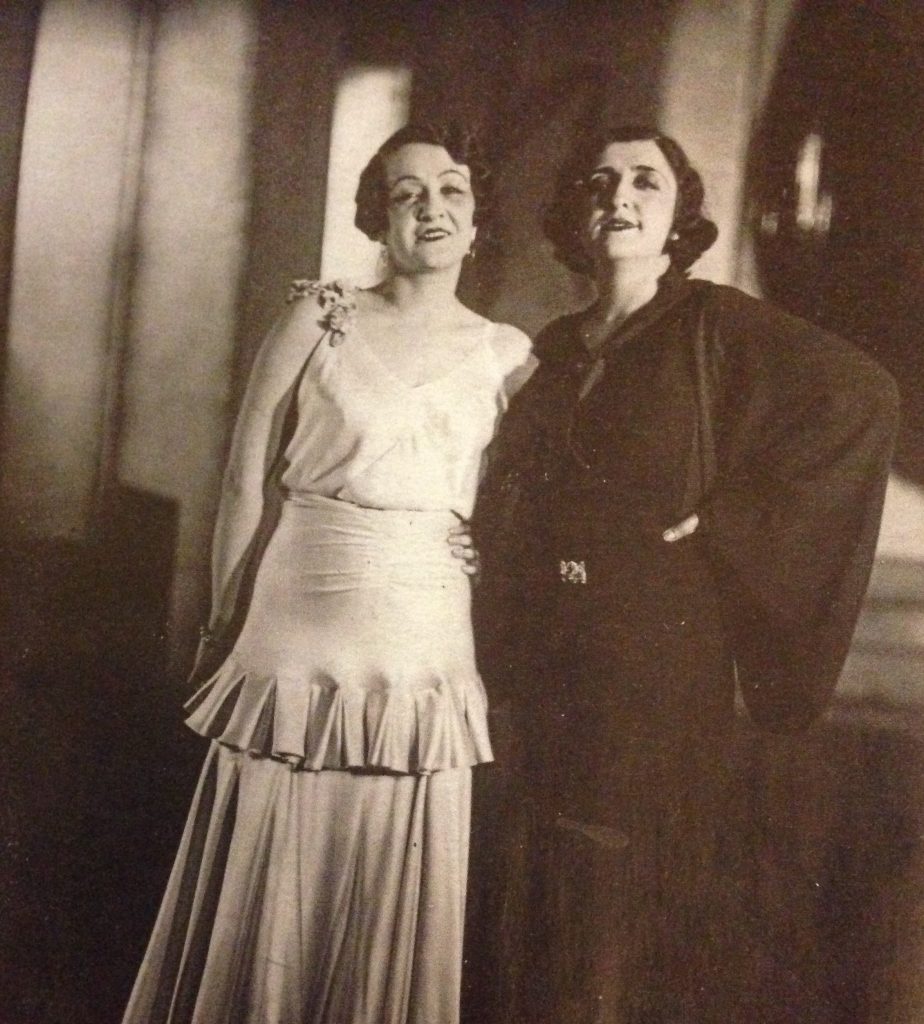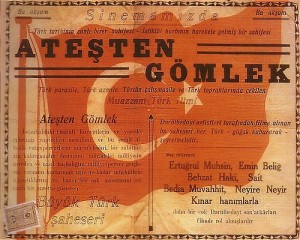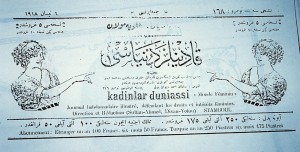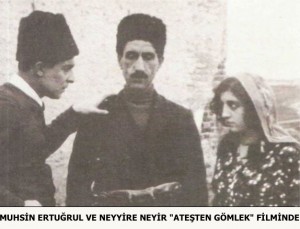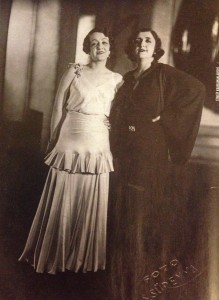The Ottoman Empire dissolved after the First World War and was replaced by the self-consciously modern and Westernized Republic of Turkey in 1923. Turkish culture under the Ottoman rule has been characterized by historians as a traditional Islamic culture that experienced very little change for centuries. What change did occur has typically been attributed to Western contact. The Republican state evolved into what later scholars called a feminist state, which made women’s equality in the public sphere a national policy. Indeed, a secular civil code replaced the Islamic law in 1926, giving women equal civil rights. It is in this transitional period that Bedia Muvahhit became a pioneer in cinema.
Within this historical context, the idea of a new Republican woman who represented the modern, secular, Westernized state, and who was expected to behave and dress in what the state defined as a modern, secular, and Western manner, was established. The new regime encouraged women to take on professions that were traditionally perceived as masculine and at times, for religious reasons, were forbidden for women. Acting of Muslim women in cinema was one example of this. However, in the early 1920s, this changed with Muvahhit and Neyyire Neyir’s performances in films as the first Muslim actresses. The state reforms of this period represented the vision of a single charismatic leader, the founder of the Republic, Mustafa Kemal Atatürk. Muvahhit recalled the story of her meeting with Atatürk and the beginning of her acting career, a turning point in Turkish cultural history, in a fascinating 1988 interview on Turkish Radio Television 2:
It is one of Atatürk’s biggest reforms for the Turkish woman to get rid of her veil and go on stage to act. Ms. Halide Edip wanted her novel to be adapted into a film and a Turkish woman to act in it. Mr. Muhsin [Ertuğrul], a friend of my husband, who directed the film invited me to act. […] My husband and his fellow actors invited Atatürk to İzmir to see their play. İzmir, at the time, was only just freed from Greek occupation. It was a city literally covered in ashes and fire. Atatürk asked who the actors in the play were. There was Ms. Isabelle, Ms. Maria, etc. [all non-Turkish names]. Then he enquired if there were any Turkish actresses. Before that a Turkish woman, called Afife Jale, tried acting in another play, but the police arrested her as she was on stage and took her away and put her in custody, and the play got cancelled. […] Atatürk asked Mr. Muvahhit why I did not act, as he had seen me in the film Ateşten Gömlek and was very impressed with my performance. […] They told me I would be acting that evening. […] Given that it was Atatürk’s order, I happily memorized all the lines during the day and performed that evening as the Principal in the play “Ceza Kanunu.” After the play, Atatürk thanked me [and] asked me to cover my head with a modest headscarf. I asked him why. He responded: “We need to get the nation used to it slowly rather than attracting negative attention. You acting on stage is in itself a big step forward.”
Although Muvahhit’s account above is particularly significant in the context of theatre, it is important to note that her visibility in film allowed her to ultimately break barriers in the theatrical world.
There are debates in Turkish film history as to the identity of the first Turkish film actress. While Muvahhit is written about as the first Muslim woman to act in a film in Turkey, there are other film historians, including Ali Özuyar, who claim that the first Muslim woman on screen was Nermin Hanım, who played Esrarengiz Şark in The Mysterious East (1922), which was directed by a French engineer (1999, 18). It is worth noting for this reason that this is a contested period as some scholars see the transition between the Ottoman Empire to the Turkish Republic from a historically linear approach, and others regard 1923 as a clear cut-off point, claiming that year as the beginning of the history of cinema in Turkey. Up to 1923, when female characters were needed in films they were chosen from those living in Turkey who were not Muslims, including Greek, Armenian, and Russian women. As noted by film historian Agah Özgüç, in the early 1920s, “women performers are typically insignificant characters…who cannot go beyond archetypal roles” (1988, 23).
When Muhsin Ertuğrul decided to adapt Halide Edip Adıvar’s novel, Ateşten Gömlek/The Shirt of Fire (also translated as The Daughter of Smyrna), in 1923, Muvahhit’s career in cinema started, marking her as one of the first Muslim and Turkish actresses in the history of cinema in Turkey. The film told the story of a young woman who worked for the liberation of her country. In order to be faithful to the novel, which focused on the Turkish National Independence War, female characters had to be Turkish. As Muvahhit’s above interview suggests, the author of this novel was also a woman who promoted the idea of women acting in films. Indeed, the author insisted that she would only permit her novel to be filmed if the lead character was performed by a Turkish Muslim woman. The film was also the first in Turkish cinema to focus on the Independence War. As its poster suggests, it was influential in establishing national identity while emphasizing the importance of Turkishness with its tagline (“A big Turkish masterpiece,” referring perhaps not only to the film itself, but also the victory of Turks in the war), as well as the use of a Turkish flag as its background image. It is in this film that Muvahhit acted alongside Neyyire Neyir and the two became pioneering Muslim Turkish film actresses. It tells the story of the Turkish Independence War by focusing on the life of a strong independent woman, Ayşe (played by Muvahhit), whose husband and child are killed during the occupation of İzmir (the third biggest city in Turkey). After leaving İzmir, Ayşe travels across Anatolia and falls in love with an army officer who is also killed at the end of the film. Ateşten Gömlek is regarded as the first of the Turkish epic films.
It is also worth acknowledging Muvahhit’s involvement in the Ottoman organization, Mudafaa-i Hukuk-u Nisan Cemiyeti, which advocated women’s rights in working as civil servants. As outlined by the research done by the İstanbul Kadın Müzesi/Istanbul Women’s Museum, Muvahhit was one of the first women to work as a civil servant and was influential in the publication of the organization’s journal Kadınlar Dünyası/Women’s World. It is thanks to this organization that, in 1913, one section of the government recruited the first-ever Muslim woman. Muvahhit took part in more than forty films throughout her career in cinema, and over two hundred plays. She translated four plays from French to Turkish. She was awarded a variety of prizes in her lifetime, including the Atatürk Art Award in 1981 and the Lifetime Achievement Award in 1993 on the 70th year of her career. Currently, one of the most prestigious theatre awards in Turkey commemorates her pioneer status in acting under the title of the “Bedia Muvahhit Theatre Award.”
***
In Article 204, issued by the Dahiliye Nezareti/Ministry of Internal Affairs, dated February 27, 1921, Muslim Turkish women were banned from acting. Within this historical and social context that offered limited career options for women, Neyyire Neyir proved to be a success story. In 1921, Neyir graduated from the Teachers Academy for Girls in İstanbul. In 1923, she joined Darülbedayi/City Theatres and got her first acting role on stage in “Othello.” This was also the year when the author of Ateşten Gömlek/The Shirt of Fire, Halide Edip Adıvar, decided to have Muslim Turkish women appear in Muhsin Ertuğrul’s film adaptation of her book. Working in collaboration with Adıvar, Ertuğrul recounted in his memoirs:
I could not miss this priceless opportunity to encourage women to act and decided to cast Turkish women for the lead female characters in this national film which offered a sight into the Independence War. I invited Bedia, Mr. Muvahhit’s wife, to perform the role of the nurse, Ayşe, in the film. In an extremely courageous move and despite the period’s reactionary ideas about women, she accepted the offer. We advertised in newspapers for the other female character, Kezban. There was only one person who applied: Münire Eyüp [Neyir], a young graduate from a school which provides teacher training. Halide Edip was extremely happy for Turkish girls to act in the film (qtd. in Yüksel 2013, n.p).
In a journal entitled Mecmua, Neyir was praised for her performance as Kezban in the film:
What makes this film a masterpiece is the role Kezban. She represents the caring and noble Anatolian woman…The Turkish woman who performs as Kezban in the film is the one who understands the author of the novel best. The heart and soul of the characters are in the actress’s face and expressions that the audience can feel (qtd. in Yüksel n.p).
This kind of positive response to the film and one of the first Muslim Turkish actresses in it suggests change in the audience’s, and hence the public’s, attitudes toward women and women’s roles. This is the reason why a review like the one quoted above is an invaluable resource in appreciating women’s contributions to cultural production in the early 1920s in Turkey.
In 1929, Neyir married theatre producer, actor, and filmmaker Ertuğrul. She continued to act in his films, including Kız Kulesinde Bir Facia/A Disaster in Maiden’s Tower (1923) and Ankara Postası/Ankara Post (1928). The majority of her artistic contributions, however, were in theatre. She acted on stage in hundreds of plays–including in plays with Muvahhit–and both set up new theatre groups and joined existing ones through City Theatres. In the mid-1920s, Neyir visited the Soviet Union to learn more about Russian theatrical styles. In 1930, Ertuğrul started publishing a journal entitled Darülbedayi, and Neyir became the editor and wrote articles about Russian literature and theatre under the name of Münire Eyüp. In 1941, together with Ertuğrul, she began publishing another journal entitled Perde ve Sahne/Screen and Stage. In its first issue, Neyir explained the main aim of the publication: “[…] to acknowledge and emphasize the significance of cinema and theatre in a period during which interest in these art forms may not be taken seriously.” She asserted that the editors of the journal “dedicated their lives to cinema and theatre and their only desire is to serve the arts” (qtd. in Yüksel n.p).
During her career, fellow actor Vasfi Rıza Zobu, who wrote an obituary for Neyir, observed the latter’s contributions to art in general and cinema and theatre in particular:
She loved reading. She wanted to learn everything and would not get tired of running after knowledge no matter what it took. She was well versed in the arts of theatre and film. I heard her talking in French with French comedians Alexander and Robin; English with English painters Cecile de Mille [sic]; and Russian with the Russian artist Pirof. She was a musician, a painter and a writer (Zobu 1944, n.p.).
Neyir was clearly an extremely significant woman in the establishment of an intellectual environment where cinema and theatre were highly regarded and discussed in detail. Neyir’s companionship with Ertuğrul is reminiscent of Simone de Beauvoir and Jean Paul Sartre’s intellectual friendship. Ertuğrul has been acknowledged as a key name in the establishment of cinema in Turkey. In fact, in textbooks about the history of Turkish cinema, he is referred to as the leader of the Theatre Period. Theatre Period here is used to connote the heavy effects of theatre on visual style in early Turkish films. What is thought-provoking and is worth exploring in further research is the influence of Neyir on his work, not only within their fourteen years of marriage (1929-1943), but also beginning in 1923 when they first worked together. It is possible that Neyir’s influence on Ertuğrul’s work is rather invisible. In fact, to this date, in many resources around Turkish cinema history, Neyir is only acknowledged for being the first Muslim Turkish actress, and perhaps for being Ertuğrul’s wife, yet there is an urgent need to fill in this gap in knowledge (both in Turkish and English) by rewriting Neyir’s significant contributions to cinema. As it demonstrates her pioneer status and significance in Turkish cultural history, it is worth noting that there is a street in her name (Neyyire Neyir Street) in İstanbul, to commemorate her work in the cinema and theatre of Turkey.

